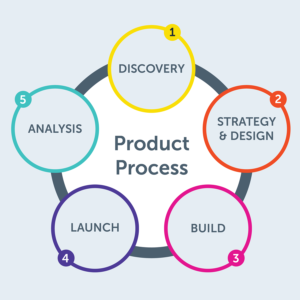Almost by reflex, some clients ask us how many design options they’re going to get for their new project, or how many revisions are included in any proposal. They’re often surprised to learn that us providing multiple design choices is bad practice and that if they have experienced this with other agencies in the past, then it is probably an indication that those agencies made a number of mistakes.

Why the discovery process is important.
When we start a project with you, we’ll always begin with the Discovery phase. This period of investigation sees us learn about your organization, your business model, who your direct and indirect competitors are and how the market you operate in works today and might work differently in the future. Only in understanding your business can we build with you a set of objectives and then deliver a strategy that achieves them.
What building a website strategy looks like.
The second phase of our process for building your website is to define a strategy to complement what we’ve learned in Discovery. A lot goes into this, but in purely practical terms:
- We identify audience types, what they’ll be looking for and what we want them to do.
- We create a website structure with components implementing key calls to action. This is called a wireframe, a skeletal layout that is free of branding and visual design elements. The idea is to document what goes where and for what purpose.
- With the page structures approved, we apply your branding – colors, fonts, images – over the top to create a high-fidelity design closely matching what will be implemented.
So, what does this mean for options?
If we’ve understood your business and the challenges it faces correctly, there should only really be one strategy to present you with in wireframe form. If there is more than one potential solution, there’s going to be the best one, and the second best one. We’re not going to want to sell you on the worst solution for your business.
With an approved wireframe, detailing the page components and layouts, we would next apply your existing or recently completed branding to this. This process is not just an attempt to make things ‘look pretty’, but colors need to be applied to calls to action and other important UI elements. Again, there could in some situations be multiple ways to do this, but there’s likely always going to be a best and a second best option.
But it’s not just about avoiding presenting clients with what we don’t recommend.
Getting bogged down in trying to dream up alternative less-than-perfect solutions just to hit arbitrary numbers of options isn’t the best use of our time and certainly not the best use of your money. It’s almost always going to be a better deal for everyone to just recommend the best idea straight off the bat.
If there are multiple choices presented for no reason other than ‘just because’ then this is costing money. There’s going to be an incentive to try to claw back some of that lost expense. To try and get something out of it. Some clients try to pick and mix elements from two different designs to create another ‘final’ design, incurring more delays and expense. Not only is this not the most efficient way out of an inefficient process, but there are serious quality concerns here. Mixing elements from something we recommend as the best choice, and something we don’t recommend as much… is only going to create a third best option.
You’ll find us quite convinced that we have the expertise to know what we’re going and what’s going to work. It’s why we were hired. If an alternate option was going to be the best one… that’s what we would have done first.
What doesn’t this mean?
It doesn’t mean in the slightest that there aren’t going to be any revisions at all! There are businesses, services and models that are difficult to completely grasp and despite out best efforts, our very first designs, be they wireframes or high-fidelity designs, might just be 90% of the way there. In such cases we’d go back and rework things multiple times until we get them just right. There’s no hard and fast number of revisions we might need, but that last 10% generally only means a few tweaks are needed.
Working with us is an experience in effectiveness, efficiency and quality.

